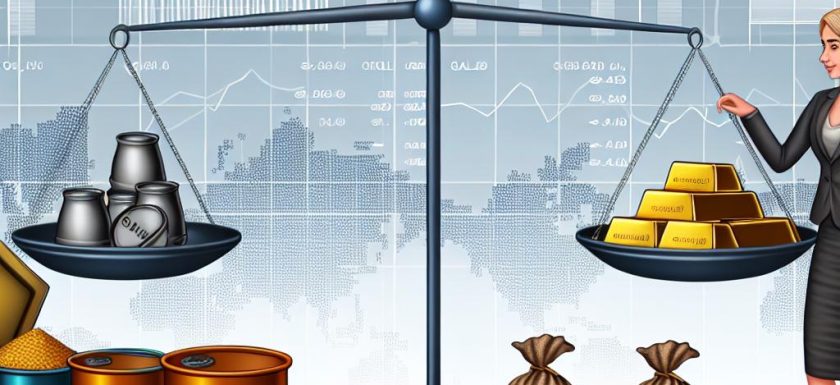Understanding Commodities as a Diversification Tool
Investors often seek diversification to reduce risk and enhance potential returns. Commodities offer a robust way to achieve diversification due to their low correlation with traditional assets like stocks and bonds. This means that incorporating commodities into your portfolio may reduce volatility and improve returns over time.
Defining Commodities
Commodities are basic goods used in commerce that are interchangeable with other goods of the same type. They are often divided into two broad categories: hard commodities and soft commodities. Hard commodities include natural resources like oil, metals, and gas, while soft commodities are agricultural products such as wheat, coffee, and cotton.
The Benefits of Commodity Investment
Commodities can act as a hedge against inflation. As prices rise, the value of commodities tends to increase, preserving purchasing power. Additionally, they offer portfolio diversification, as commodities often have a different performance cycle compared to stocks and bonds. The cyclical nature of commodities means that they can be less correlated with other asset classes, offering protective benefits against broad market downturns.
Investors, therefore, can potentially stabilize overall portfolio returns by including commodities. Moreover, commodities provide a unique exposure to economic trends, such as urbanization and industrialization in emerging markets, which can drive demand for specific resources. When bonds and equities may underperform due to economic slowdowns or recessions, certain commodities might benefit from opposite market pressures.
Understanding Market Dynamics
Commodity markets are influenced by supply and demand factors, geopolitical events, and economic cycles. For instance, a disruption in oil supply due to geopolitical tensions can lead to price spikes. Investors should be aware of these dynamics as they can greatly affect commodity prices.
These market dynamics are not limited to energy commodities; agricultural commodities can also experience significant volatility. Weather conditions like droughts or floods can drastically impact crop yields, influencing supply and consequently prices. In the metals market, technological advancements or alternatives, such as the growing demand for electronic vehicles, can affect demand for specific metals like lithium or copper.
To understand commodity markets fully, investors need to stay updated with global news and trends. Different commodities react differently under various economic conditions, which requires careful analysis to anticipate price changes. Thus, a keen insight into the market dynamics can prove invaluable in making informed investment decisions.
Ways to Invest in Commodities
Direct Investment: Buying physical commodities, such as gold bars or barrels of oil, represents a direct investment. This method involves owning the actual commodity, providing tangible asset security. However, holding physical commodities requires proper storage and insurance, making it less practical for individual investors. It suits those who appreciate tangible assets and are equipped to handle the logistical challenges associated.
Futures Contracts: Investing through futures contracts permits investors to buy or sell a commodity at a predetermined price at a specific future date. This investment form demands a sophisticated understanding of market trends and poses significant risk. Since futures markets can be highly leveraged, price movements can greatly amplify both profits and losses. This method is often appealing to individual investors with a strong grasp of market insights looking for high risk-reward potential.
Commodity Stocks: Purchasing stocks of companies involved in commodity production, like mining firms or oil companies, provides indirect exposure. This approach reduces commodity-specific risks by tying investments to corporate performance. Through these stocks, investors can benefit from dividends and capital gains, alongside exposure to underlying commodity prices.
Exchange-Traded Funds (ETFs): Commodity ETFs offer a simpler and more liquid alternative as they track the price of a commodity or a basket of commodities. Being exchange-traded, they provide liquidity and ease of management, enabling investors to buy and sell shares easily. This method suits investors seeking diversification with less involvement in intricate market trading.
Mutual Funds: These funds invest in a diversified portfolio of commodity stocks or futures contracts. Managed by professional portfolio managers, they offer investors a hassle-free way to benefit from commodity markets without the need for direct decision-making. For those who prefer professional management, mutual funds offer diversified exposure with relatively lower individual asset risk.
Challenges Associated with Commodity Investing
Commodity investments have unique challenges. Their prices can be volatile due to factors like weather patterns and geopolitical events. Moreover, not all commodities are easy to access for individual investors, and they may encounter high transaction costs. Storage and spoilage present additional risks for physical commodities. Regulatory changes can also impact market access and costs.
Investors must weigh the complexities of each investing method. While futures contracts can offer leverage, they present high risks due to potential for losses if market prices move unfavorably. Similarly, while physical commodities offer tangible ownership, they also involve costs like storage and insurance. Understanding these challenges and preparing accordingly is key to navigating commodity investments.
Conclusion
Incorporating commodities into your investment portfolio requires an understanding of both the benefits and challenges. By carefully selecting the right investment vehicle and staying informed about market dynamics, commodities can effectively diversify and strengthen your portfolio. An investor must evaluate market conditions, demand cycles, and geopolitical influences that drive commodity prices to make sound investment decisions. For example, heavy reliance on geopolitical stability for energy commodities demands vigilant monitoring of global political climate. As markets evolve, maintaining a balanced portfolio that includes commodities can lead to greater risk-adjusted returns and provide protection against unexpected market shifts. For further reading on investment strategies and market analysis, you can visit Investopedia for more detailed articles.
This article was last updated on: August 10, 2025
